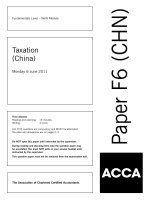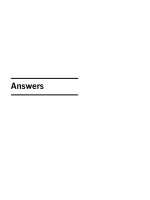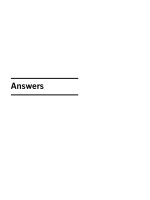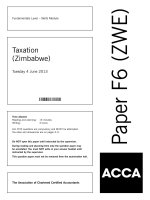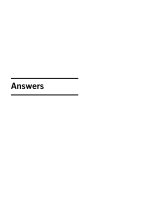ACCA f6 taxation south africa 2011 jun answer
Bạn đang xem bản rút gọn của tài liệu. Xem và tải ngay bản đầy đủ của tài liệu tại đây (172.08 KB, 8 trang )
Answers
Fundamentals Level – Skills Module, Paper F6 (ZAF)
Taxation (South Africa)
June 2011 Answers
and Marking Scheme
Note: The ACCA does not require candidates to quote section numbers or other statutory or case references as part of their answers.
Where such references are shown below [in square brackets] they are given for information purposes only.
Marks
1
Mrs Mokomele
(a)
Employees tax calculation
R
Annual cash salary
Monthly travel allowance R5,000 x 80% x 12
Employer contributions to medical aid (all taxable)
R2,500 x 12 [p12A – 7th Schedule]
Clothing allowance – not exempt [per s.10(1)(nA)] as not distinguishable
from everyday clothing – R500 x 12
Bursary for son – fully taxable as Mrs Mokomele earns remuneration of
more than R100,000
Subsistence amounts
May allowance (no travel and not repaid)
Remaining allowances
No record of actual expenditure – use Government regulation rate –
R276 x 25
Contribution to pension fund:
Actual – R400,000 x 10% = R40,000 limited to greater of:
R1,750 or
7·5% x R400,000 (being retirement funding employment
income) = R30,000
Contribution to retirement annuity fund:
Actual – R4,000 x 12 = R48,000 limited to greater of:
R1,750; or
R3,500 – R30,000 (negative therefore not applicable)
15% x R465,400 – R400,000 + R30,000 (being 15%
of non-retirement funding income) = R14,310
Taxable income from employment trade for employees tax
Tax per the tables – R114,750 + 38% x (451,090 – 431,000)
Less rebate (primary only as less than 65 years of age)
Total employees tax withheld
(b)
31 August 2010
28 February 2011
R
400,000
48,000
½
½
30,000
½
6,000
1
9,000
1
1,800
1
½
600
––––––––
495,400
½
7,500
(6,900)
––––––
½
(30,000)
––––––––
465,400
1
½
(14,310)
––––––––
451,090
––––––––
1
122,384
(10,260)
––––––––
112,124
––––––––
1
½
–––
10
–––
2
–––
11
Marks
(c)
R
As the RAF deduction will have to be redetermined, begin with the taxable
income before RAF contribution
Subtract the travel allowance inclusion (as this must be redetermined)
Travel allowance R5,000 x 12
Less business travel
Fixed cost per kilometre (in cents)
R116,012/26,000 kms x 100
Fuel (in cents per km)
Maintenance (in cents per km)
Cost per km
Reduction: Business kms (5,000) x cost per km (R6·317)
Investment income
South African dividends received (other than from CIS)
Dividend from CIS within 12 months of receipt by CIS: CIS treated as a conduit
South African dividend exemption
Distribution from CIS outside of 12 months since receipt by CIS
Exemption as amount taxed in the CIS [s.10(1)(iB)]
South African interest
South African interest from CIS (within 12 months)
South African interest exemption (limited to)
465,400
(48,000)
––––––––
417,400
½
446·2c
110·3c
75·2c
––––––––
631·7c
––––––––
(31,585)
––––––––
1
½
½
35,000
10,000
(45,000)
––––––––
30,000
(30,000)
––––––––
80,000
40,000
(22,300)
––––––––
Contribution to retirement annuity fund:
Actual – R4,000 x 12 = R48,000 limited to greater of:
R1,750; or
R3,500 – R30,000 (negative therefore not applicable)
15% x R548,515 – R400,000 + R30,000 (being 15% of
non-retirement funding income) = R26,777
Capital gain
Less annual exclusion (as no other capital gains or capital losses for
the current year ending 28 February 2011)
Aggregate and net capital gain
28,415
––––––––
445,815
1
0
½
1
½
0
1
1
97,700
½
½
½
5,000
½
0
––––––––
548,515
1
(26,777)
––––––––
521,738
1
550,000
(165,000)
––––––––
385,000
½
½
(17,500)
––––––––
367,500
––––––––
½
Inclusion at 25%
91,875
––––––––
613,613
The taxable income figure confirms that the loss from Property B may not be used
Tax per the tables – R160,730 + 40% x (613,613 – 552,000)
Less rebate (primary only as less than 65 years of age)
Normal tax
Less employees tax withheld
Final tax liability
An assessed loss for Property B will be carried forward amounting to (R13,000 + R8,000)
12
1
½
60,000
Rental trade
Profit from Property A
Loss from Property B ring-fenced and may not be used here if taxable income
finally determined remains over the threshold at which tax is levied at the
maximum marginal rate.
Capital gains tax:
Proceeds
Base cost
R
½
½
185,375
(10,260)
––––––––
175,115
(112,124)
––––––––
62,991
––––––––
21,000
1
½
½
½
–––
18
–––
30
–––
Marks
2
Blend Co (Pty) Ltd
(a)
(b)
As Blend Co (Pty) Ltd is not held by natural person shareholders, it cannot be a small business corporation (as
defined).
1
–––
Income tax effects
R
(i)
Machine A
Manufacturing machine allowance [s.12C]
R500,000 x 20% (year 4 and last of the allowance)
Recoupment [s.8(4)(a)]
Selling price R40,000 limited to cost (R500,000)
Less Tax Value: R500,000 – R200,000 (40%: 2008) – R100,000
(20%: 2009) – R100,000 (20%: 2010) – R100,000 (above)
(100,000)
40,000
0
––––––––
Capital gain or capital loss:
Proceeds
Less recoupment
40,000
(40,000)
––––––––
Less base cost:
Expenditure
Less allowances granted
500,000
(500,000)
––––––––
Capital gain/capital loss
(ii)
R
Machine B:
Purchase price of machine from Test Limited to connected person rule [s.23J]:
Acquisition cost of connected person
Less allowances claimed by connected person
R400,000 x 20% per year as second hand x 3 years
Add recoupment for connected person
Market value R175,000 limited to cost (R400,000)
175,000
Less Tax Value: R400,000 – R240,000 = R160,000
(160,000)
––––––––
Add capital gain multiplied by inclusion rate of 50%
Proceeds (175,000) less recoupment (R15,000)
160,000
Less: Expenditure (R400,000) less allowances (R240,000)
(160,000)
––––––––
Connected person value
Manufacturing machinery allowance [s.12C]
R175,000 x 20% (second-hand acquisition)
½
½
40,000
1
0
½
½
0
––––––––
0
––––––––
½
½
250,000
400,000
½
½
(240,000)
1
15,000
½
½
0
––––––––
175,000
––––––––
½
½
(35,000)
½
(600,000)
½
(103,448)
1
(25,000)
1
(126,000)
½
(12,500)
½
(3,000)
½
(80,000)
1
(vi) The warehouse is not a manufacturing building and does not qualify for the manufacturing building
allowance.
½
The warehouse also predates the commercial building allowance. No allowance was therefore claimed on
the old warehouse.
½
(iii) Lease and lease improvement
Monthly lease payments – R50,000 x 12
Leasehold improvement – deduction is limited to value stipulated in the
lease spread over the remaining lease term or 25 years (whichever the lesser)
R1,500,000/(10 years less 4 months) x 8 months
Excess cost above R1,500,000 was incurred for a manufacturing building.
Lessee entitled to claim manufacturing building allowance on such excess
Manufacturing building allowance – 5% x (R2,000,000 – R1,500,000)
Manufacturing allowance for Machine D [s.12C]
R630,000 x 20% (year 2)
Moving costs of Machine D – spread over remaining tax life of the asset
moved [s.12C(6)]
37,500/3 years
(iv) Renewal of patent is fully deductible [s.11(gB)]
(v)
The finger loss is in the nature of risks closely aligned with the type of business
that Blend conducts. As a result, the amount should be fully deducted [see
PE Tramways case for reference]
Note: If a candidate applies the new legislation to the old warehouse [s.13quin] credit should still be
given. No additional credit will be given for the adjusted capital gains tax calculation.
13
Marks
Tutorial note: No election can be made to defer the capital gain. As a voluntary disposal of a building and
a building that was not a depreciable asset, the qualifying criteria are not met.
R
Capital gain:
Proceeds
Base cost
1,200,000
(800,000)
–––––––––
400,000
–––––––––
Capital gain
The new warehouse qualifies for the commercial building allowance
[s.13quin] at a rate of 5% per annum
5% x R2,300,000
Capital gains inclusion:
Total capital gains (0 + 400,000)
Total capital losses
½
½
(115,000)
400,000
0
–––––––––
400,000
–––––––––
Aggregate and net capital gain
Inclusion at 50%
(c)
R
½
200,000
For the purposes of trade
Expenditure actually incurred
In the production of income
Not of a capital nature
½
½
½
½
Expenditure incurred in the production of exempt income is not permitted as a deduction [s.23(f)].
½
It is understood from the scenario that the audit fees relate to the company and its income as a whole.
½
Dividends from the South African companies are exempt from gross income and therefore not income as
defined.
1
This implies that the audit fees should not be fully permitted as a deduction as some of the fee charged relates
to the audit of the dividend income stream.
½
The audit fees also relate to the preparation of consolidated financial statements and not exclusively to the
generation of income. However, such consolidated financial statements may be used to obtain credit from
financial institutions to on-lend to the group companies.
1½
Apportionment on the basis of income earned may therefore not be appropriate. An appropriate apportionment
must be determined examining all the facts and on a balance of probabilities basis. It is clear, however, that the
full audit fee is not deductible as some of the fee relates to the audit of the exempt income stream (dividends).
1
Tutorial note: Further information may be found in ITC 1842 72 SATC 118 which discusses the usual principles
pertaining to the deductibility of an expense.
(a)
½
–––
17
–––
The deduction of the audit fees by Tea Co Holdings Ltd requires the audit expense to be:
–
–
–
–
3
½
–––
7
–––
25
–––
Holiday Home
No disposal at date of emigration as property is immovable property in South Africa.
Date of disposal is therefore 1 November 2010.
½
½
Furniture and fittings
As movable assets, these are deemed to be disposed of on emigration, being 30 June 2010.
Subsequent disposal when Mrs Mpotulo is in Australia is irrelevant for South African capital gains tax.
1
1
Motor car
Movable asset would result in a deemed disposal on emigration, 30 June 2010.
½
Kruger rands
Disposal was before emigration – date of sale is the date of disposal, being 1 May 2010.
14
½
–––
4
–––
Marks
(b)
Holiday Home
R
Proceeds (actual on sale)
Less Base Cost:
Valuation date value:
(i) 20% x (Proceeds – post 1 Oct 2001 expenditure) =
20% x (3,750,000 – R250,000)
(ii) Market value on 1 October 2001
(iii) Time apportioned base cost:
R = 3,750,000 – 187,500
B = 320,000
A = 250,000
R
3,750,000
700,000
N/A
1
½
1
½
½
P = R x B/(A + B)
P = 2,000,000
N=4
T = 10
1
1
1
Y = B + ((P – B) x N)/(T + N)
Valuation date value chosen – highest
Post 1 October 2001 expenditure:
Extension
Selling costs
800,000
––––––––––
––––––––––
1
800,000
1
250,000
187,500
––––––––––
Capital gain
Furniture and fittings
Proceeds (market value on emigration)
Less base cost
400,000
(750,000)
––––––––––
(350,000)
Capital loss
Disregard capital loss – personal use asset
57,000
(23,000)
––––––––––
34,000
Capital gain
Total capital gains (not disregarded)
Total capital losses (not disregarded)
2,546,500
0
––––––––––
2,546,500
(17,500)
––––––––––
2,529,000
(100,000)
––––––––––
2,429,000
––––––––––
Less annual exclusion
Aggregate capital gain
Less assessed capital loss brought forward
Net capital gain
Taxable capital gain at 25% = 2,429,000 x 25% =
2.
½
½
½
½
½
Kruger rands
Proceeds (actual on sale – preceded emigration)
Less base cost
1.
½
½
½
Motor car
Proceeds (market value on emigration)
Less base cost
(a)
1,237,500
––––––––––
2,512,500
1,600,000
(1,500,000)
––––––––––
100,000
Capital gain
Disregard capital gain – personal use asset
4
½
½
½
½
½
½
607,250
½
–––
16
–––
20
–––
Where the total value of taxable supplies exceeds R1 million over a 12-month period, the person becomes
liable to register for value added tax (VAT) at the end of the month in which the turnover exceeds
R1 million.
½
Within 21 days from the month end in which the person becomes liable, an application must be made for
registration as a value added tax (VAT vendor).
½
The taxable supplies considered for the registration threshold stipulated in (1) above does not include the
amounts received on replacement of capital assets.
½
15
Marks
3.
The sale by Dr Daniels of the furniture, while still a taxable supply, is not considered for the purposes of
the registration threshold.
½
If his other taxable supplies made regularly and continuously in the course or furtherance of his enterprise
remains below R1 million, he does not have to apply for registration as a vendor.
1
A full VAT invoice must include the following:
–
–
–
–
–
–
–
4.
(b)
The words ‘Tax Invoice’ prominently displayed
Name, address and VAT number of Dr Daniels
Name, address and, where the patient is a VAT vendor, the VAT number of such patient
A serialised invoice number and the date of issue of the invoice
A proper description of the services and goods supplied
The quantity or volume of the goods or services
Either:
–
The value of the supply, the amount of tax charged and the consideration for the supply; or
–
The total consideration value and either the amount of tax charged or the rate at which the tax
was charged.
Bad debts generate a VAT input claim. Effectively the output VAT charged is reversed in the VAT period in
which the debt is considered irrecoverable.
1
1
1
–––
9
–––
The supply by the website company of the electronic books is an imported service [as defined in s.1 of the VAT
Act], being a supply by a non-resident to a resident who will use the supply other than for purposes of making
taxable supplies. As Dr Daniels is using the books for recreational purposes, this purchase meets the definition.
2
The time of supply for such imported service is the earlier of issuance of an invoice or when payment is made.
Since the foreign company does not issue invoices the time of supply must therefore be the date of payment,
being 15 May 2011.
1
The value is the open market value or actual consideration, whichever is greater. The only value supplied is that
of R2,310 and must be the appropriate value.
1
The transaction must be declared by Dr Daniels to the Commissioner in the prescribed form within 30 days of
the time of supply (15 May 2011). Dr Daniels will have to pay VAT on the imported service of 14% x R2,310
= R323.
2
Tutorial Note:
The definition of days is derived from the Interpretation Act and is reckoned by including the first day (i.e.
15 May 2011) and excluding Saturdays, Sundays and public holidays. For this reason the exact date is not
expected in the solution (but for reference would be 27 June 2011).
5
½
½
½
½
½
½
–––
6
–––
15
–––
Max Green
(a)
The service is mainly to residential customers (who themselves are not VAT vendors).
½
By registering as a VAT vendor, Max will have to charge VAT on his services, increasing the costs to his
non-VAT vendor customers while producing no further revenue for himself. Stated differently, Max may have to
charge more than the competition in this industry who are not registered for VAT.
½
Much of the cost in Max’s business is likely to be labour in the collection and sorting of the recycling collected
from the residential customers.
½
As the payment of wages does not result in a VAT input claim, there is no advantage to Max to register the
business for VAT.
(b)
As Max is under 65 years of age and earning income other than remuneration (such as his salary) he is a
provisional taxpayer.
Tutorial note:
As he is ‘carrying on a business’ he does not qualify for the passive taxable income exemption from provisional
tax, which provides that persons under 65 not carrying on a business may have other taxable income from
interest, dividends or rental but not exceeding R20,000 to avoid registration as a provisional taxpayer.
16
½
–––
2
–––
½
Marks
Persons qualifying as provisional taxpayers must apply for registration within 30 days of becoming a provisional
taxpayer.
½
Max became a provisional taxpayer on 15 April 2010 when he began earning income from carrying on a
business.
½
He therefore must register as a provisional taxpayer within 30 days after 15 April 2010.
½
Tutorial Note:
The definition of days is derived from the Interpretation Act and is reckoned by including the first day (i.e.
15 April 2010) and excluding Saturdays, Sundays and public holidays. For this reason the exact date by which
Max must register is not expected in the solution (but for reference would be 28 May 2010).
(c)
R
Salary 12,000 x 12
Interest earned
Interest exemption for under 65s
30,000
(22,300)
Business income
Pre-trade expenditure [s.11A]
Deductible revenue expenditure
450,000
(20,000)
(200,000)
––––––––
Taxable income
Tax per the tables: 70,650 + 35% x (381,700 – 305,000)
Rebate
Tax liability before tax credits
Employees tax
Provisional tax
Total tax liability
17
R
144,000
7,700
––––––––
230,000
––––––––
381,700
––––––––
97,495
(10,260)
––––––––
87,235
(15,940)
(25,000)
––––––––
46,295
––––––––
–––
2
–––
½
½
½
½
1
½
1
½
½
½
–––
6
–––
10
–––
